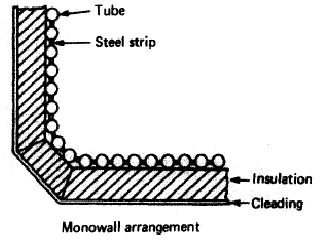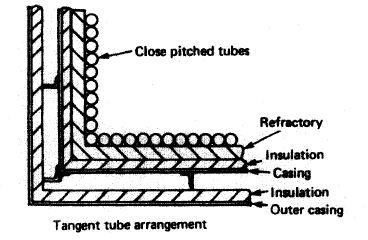Understanding the Boiler Furnace Wall Construction
Introduction
Boiler furnace is that part of the boiler where the temperature of the system reaches the highest. The furnace produces the necessary heat required by burning the fuel oil inside its small closed chamber. Because of the fuel combustion the internal temperature goes extremely high and for this reason it is necessary that the walls of the furnace are stacked with proper high temperature withstanding material. In this article we will go through the basic furnace walls designs used in constructing a boiler.
The type of material used in the the furnace walls of the boilers is known as refractory material. The refractory acts as both an insulating material and a protective layer for preventing the external walls of the boiler from getting damage.
However, the problem with using refractory material in the furnace walls is that due to high temperature and pressure the material tends to come out of its position, especially from vertical walls. Reinstalling these refractory material becomes a tedious and cumbersome job. Due to these reasons all the modern boilers use furnace walls having designs other than refractory materials.
Alternatives to Refractory Material
Alternatives to refractory materials are two designs of water wall arrangements devoid of exposed refractory materials. The two types of arrangements are:
- Tangent tube
- Monowall or membrane wall
Tangent Tube
In tangent tube arrangements, small diameter tubes are closely pitched together to form an arrangement backed by three layers, namely - refractory, insulation and boiler casing. The problem with this arrangement is that, in case of tube failure the welded repairs become a bit difficult to carry out. If repairing is not convenient, the broken tube is to be plugged from both the sides. When plugged, the tube should be covered with refractory material to protect the insulation layer behind it.
Monowall Membrane
In monowall membrane, all the steel tubes are joined together with the help of a steel strips to form a gas tight enclosure. Though it forms a gas tight structure, it requires an insulation and cleading on the outside. The advantage of a monowall membrane is that it eliminates the problems attached with refractory and expanded joints. In case a tube fails, plugging of tube needs to be done from both the sides without the use of any refractory material. The design is such that the failed tubes, if plugged would neither require any future inspection nor will they create any functional problem.

Images
Introduction of Marine Engineering 2nd Edition by D.A Taylor
